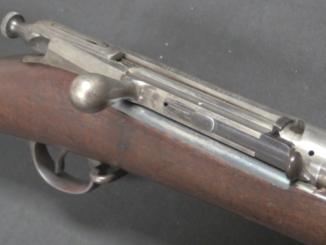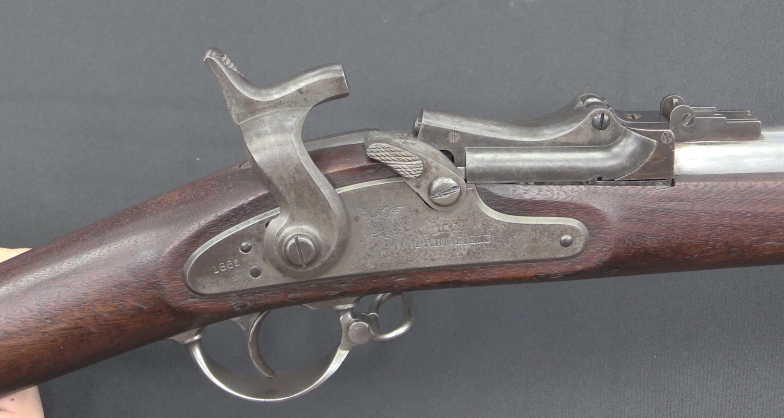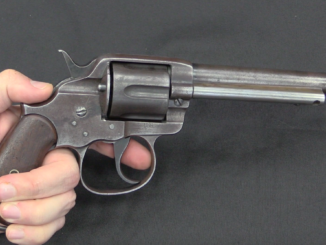Sam Colt’s very first work was done in Baltimore, but this ended fairly quickly, and it was with his subsequent move to Paterson New Jersey that the first true production Colt firearms were made. Colt set up a small shop there and introduced both handguns and rifles using his patented system in which cocking the hammer of a revolver would rotate and index the cylinder. Initially the rifles and carbines were substantially more popular than the handguns, mainly because of caliber. The pistols were tiny .28 caliber pocket models, and remarkably underpowered, while the rifles were .40 caliber and more practical. Both were very expensive, though. Only 200 of these first model rifles/carbines were made, with 50 of them going to the Army for the Seminole Campaign in Florida.
Related Articles

Bolt Action Rifles
Chaffee Reece Model 1882: A Good Idea on Paper…
Patented in 1879 by Reuben Chaffee and General James Reece, the Chaffee-Reece rifle is an excellent example of how an idea that seems good on paper can easily become untenable in a fielded rifle. The […]

Conversion
First Pattern 1865 Allin Conversion – Trapdoor Springfield at RIA
As the US Civil War drew to a close, it was quite apparent to everyone that muzzleloading rifles were obsolete, and any military force wishing to remain relevant would need to adopt cartridge-firing weapons. However, […]

Revolver
Colt 1902 Philippine Model
The Colt 1902 Philippine Model revolver is a modified version of the Colt 1878 Double Action Army or Frontier model pistol. This was Colt’s first entry into the large-frame double action revolver market, following just […]

Notice the top strap?… Extended to the barrel, but not connected and secured there. Seems purposedly made.
“The pistols were tiny .28 caliber pocket models, and remarkably underpowered, while the rifles were .40 caliber and more practical.”
Does anyone have ballistic data? I am aware that with percussion revolvers, amount of powder depend on user, but I assume there were some recommended loads.
I suspect that “remarkably underpowered” may refer to the modern-day concept of what is considered an effective round for self-defence (based on what we know TODAY) rather than as it related to the 19th-century’s accepted standard or commonality.
In addition to these early .28 Colt revolvers, it seemed that 7mm (.28 cal) Lefaucheux pinfire pocket revolvers were popular for that time, and even the later .32 caliber centerfire (black powder derived) cartridges common for late-19th century/early 20th century Colt and S&W pocket revolvers are considered severely under-powered by modern concepts of ballistic effectiveness.
7mm (aka .276in in Britain) was pretty much the “default” bore size for compact defensive pistols in Europe at the time.
Besides the LeFaucheuxs, percussion pepperbox pistols by Mariette and others were commonly made in 7mm, and this persisted into the pinfire/early rimfire era with various makes of short-barrelled pepperbox pinfire “fist guns”, that were popular with the street toughs in French cities;
http://www.collectorebooks.com/gregg01/pinfire/DSC05039.jpg
Colt, who had done a good bit of traveling before settling down in the arms business, was probably simply following the common custom of the time in making his ultra-small pocket pistols in .28/7mm.
Also, the Paterson revolvers in “belt pistol” size were made in not just .36 and .40 caliber but also in .31. Again, at the time that was considered adequate by European standards, assuming that the shooter sensibly shot for the heart or the head.
Our ancestors’ ideas on “stopping power” were less concerned with what you hit the opponent with than ensuring that you hit him somewhere that would do serious, preferably fatal, damage.
And the point of a revolver, to them, was less engaging multiple targets than hitting the same target several times to get him to lie down and stop doing whatever it was that caused them to conclude he needed to be shot to begin with.
For this type of tactical environment a 7mm or so sidearm actually makes fairly good sense. Much as a compact .22 revolver does today.
Also note that Smith & Wesson started out in revolvers (after the Volcanic bombed in the marketplace) with a .22 rimfire revolver, and when the Civil War began introduced the Model 1 1/2, a “full-grown” belt pistol in .32 rimfire.
The latter was deemed adequate as a cavalry sidearm, mainly because its ballistics (80-grain bullet @ 950 F/S for 160 FPE) was roughly equal to the Colt .36 percussion “Navy” revolver’s typical loads. Which was considered adequate to the purpose at the time.
The prevailing wisdom then seemed to be that bullet placement mattered a bit more than the exact size of the bullet being placed.
Maybe they had something there.
cheers
eon
Daweo,
It’s hard to describe how tiny these pocket Paterson revolvers are. The first time you see one in person you’ll feel like you’re looking at a miniature, they are that small. I can’t imagine what the ballistic performance would be like. Maybe something between a BB cap and a .22 Short?
.28 Rimfire, which was made for converted revolvers and in derringers while formally 25-10 used 5-7 grains of black powder. So, pretty wimpy.
The old .25 Short rimfire (introduced 1860, only discontinued in 1920) fired a 43-grain bullet at 750 F/S for 53 FPE.
The slightly bigger .30 Short rimfire (made during the same time span) launched a 58-grain slug at 700 F/S for 62 FPE.
You could expect the .28 percussion Colt to be somewhere in that area, power-wise.
By comparison, a typical modern .22 Short rimfire load is a 29-grain bullet at 1040 F/S for around 70 FPE. Beretta used to make very small pocket automatics in that caliber as self-defense weapons, and at close range a hit from one in the right place is more than adequately lethal.
cheers
eon
It’s not surprising that these rifles were ultimately rejected by the U.S. Army, as were all repeating rifles for many decades to come, as the military brass continued to demonstrate a strong preference for single-shot rifles all the way through to the very end of the 19th century.
It would suggest that perhaps the army failed to develop and deploy the kind of tactics that would have exploited the full capabilities of these 19th-century “assault rifles”.
In a classic battlefield role, such weapons may have been more of a hindrance than an asset, with their ultra-long reloading times (how were these early Pattersons even reloaded, anyway?) upsetting the pace and synchronization of the formation that they may have been haphazardly mixed in with.
It’s interesting that the one batch of these rifles bought by the military was to battle an adversary which did not employ standard European-American battlefield orthodoxy — and had their own rapid-fire ability in the form of arrows.
Until the development of cartridge cases with clips or chargers (or replaceable magazines) the average rate of fire of repeating rifles wasn’t any faster than with single shot rifles. You still had to handle each cartridge (or bullet and charge) individually. You therefore gained nothing in terms of average rate of fire. Clips or chargers let you handle 5 or 6 rounds in one motion and that reduced number of manual handling actions is what would increase the effective average rate of fire.
This was especially the case with revolving rifles such as this one. The average rate of fire was probably much less than with a muzzle loader, since the reloading procedure was much more complex.
What a revolving rifle did give you was a rapid fire for a few shots (8 in this case). However, there was no way to save that for when the enemy was close at hand. There was no “magazine cut-off” with a revolving rifle. Once your 8 shots was done, you were basically disarmed until you could reload it. An enemy could use that pause in fire to charge in before you could reload.
With revolving pistols this was less of an issue, since they were very short range weapons only. Pistols were carried by cavalry who could charge in and charge back out, or infantry officers who were supposed to be commanding their men, not firing at the enemy except in short range self defence (and they had their sword for hand to hand anyway, once the pistol was discharged).
As a military firearm, a revolving rifle had very limited practical use. Responding to a close range ambush by a numerically superior but poorly armed enemy is probably about it. And that’s probably what it was used for in this case.
aa and MG,
These early Patersons came with extra cylinders and a separate reloading tool.
The idea was to pull the wedge, remove the empty cylinder, and replace it with a fully loaded and capped cylinder.
Your individual firepower was only limited by the number of loaded cylinders that you had on your person, or being carried by your ammunition bearer.
That was the theory at least. ^__^ In practice they were delicate and prone to parts failure, and all revolvers in the black powder era were limited by fouling.
Basically the Army called revolving rifles a bunch of “new-fangled fickle pampered poodle guns” which could only make a soldier’s life more difficult in that the complexity and cost of the revolving rifles outweighed any benefits given to the troops. The box magazine with chargers/clips ultimately became the most efficient (expense-wise and speed-wise) means of retaining a reserve of ammunition for manually operated repeating weapons. Revolvers would need speed-loaders/moon clips and a means of accessing the entire cylinder to change out cartridges in order to load quickly without the whole “spare cylinder in my pocket” thing that came with the Remington 1858.
Did I mess up?
Nope. There were attempts to create extremely-high-firepower weapons even then, less to create a Vietnam-style “sustained firescreen” then just to reduce the need to stop and reload while firing by the numbers, in volley, on command. The most obvious example was the Porter rifle;
https://www.forgottenweapons.com/ria-porter-turret-rifle/
As can be seen, the Porter’s “turret” could be removed and replaced very quickly. Swapping in a loaded one for an empty would have been faster and more convenient than changing a revolver cylinder, not unlike changing box magazines on a modern rifle.
Porter took it one step farther with a one-off prototype with not only the “turret”, but a top-mounted cylindrical “tower” magazine that reloaded the turret chambers as they were presente4d to it pointed “straight up”. It held enough powder and ball for another 20 shots in addition to the ten in the turret, two reloads per chamber, for a total of 30.
The small drawback, of course, was that a stray spark could reach the powder reservoir. At which point the “magazine” would likely do a marvelous impression of a fragmentation grenade- right in front of the shooter’s face.
Giving a very literal meaning to the phrase, “getting your head blown off”.
“Infantry firepower” had a different definition back then. It meant every man firing in unison on command to blast the opposing force with lead directed exactly as the commander wanted it. The infantry platoon or company was a single mass-fire weapon, acting only at the behest of its leader.
Individual accuracy was irrelevant. What mattered was volleys going where directed. Mostly “ahead”, “right oblique”, or “left oblique”. And the order was “Ready…Level… FIRE”.
“Aim” wasn’t in there, anywhere.
This is the main reason the smoothbore musket ruled the battlefield for over 300 years, from matchlock to early percussion era.
It was the exact right tool for the job at hand when used according to the doctrines of its day. And the reason for the old saying about God being on “the side of the big battalions”.
cheers
eon
Eon, the command to “aim” was incorporated into the American version of the Manual of Arms in 1777 I think. I can look it up if necessary. It was a concession to American culture rooted in hunting and target shooting pastimes. For similar reasons the standard Continental formation was two ranks deep instead of the British preferred three ranks, in order to maximize individual marksmanship in the context of the volley fire control methodology. It proved effective , as did our improved maneuver units and combined arms philosophy ( integrated artillery with infantry brigades). All these lessons had to be relearned once the army was completely disbanded after the war, of course.